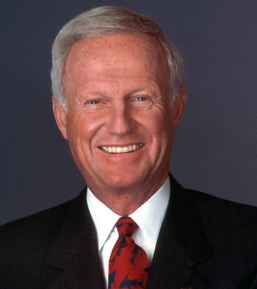Bob T. is the kind of guy parents dream of raising. Teachers long to claim. Young women always eye. And now almost every law firm in San Francisco is eager to hire.
What's so special about Bob? His resume reveals good, but not outstanding grades. An athletic scholarship. A respectable, but not prestigious law school. Solid work experience, but like most neophytes, no gold stars -- as yet. So, what gives?
As soon as you meet Bob, you know the answer: He's a confident young man -- not cocky, but he exudes a positive self-image. His "I-can-do-it spirit" appeals to everyone. It's this exceptional quality that propels him, helping him overcome whatever difficulties stand in his way.
Traits like Bob's don't automatically come with a law degree. Recruiters know it. They prize Bob's self-esteem, aware that it's essential for a successful career.
No single factor is as important to career success as self-esteem. People with healthy self-esteem have a basic sense of their own competence and worth, a fundamental certainty about their ability to cope with problems and adversity.
In a person with self-esteem like Bob's, you usually find four basic qualities: self-confidence, faith in oneself, a positive self-image and freedom from fears of success and failure. Individuals with secure self-esteem take responsibility for their actions, insist on living up to their own standards and seek the stimulation of demanding goals.
Confidence grows from solid feelings of self-acceptance. Self-assured people like Bob are content to be themselves. They feel they can master challenges and overcome obstacles. Their morale stays high, their ultimate goal is always in sight and their work to achieve it is fulfilling.
While self-doubters agonize, confident people act. These doers feel in control of their lives. They believe whatever they achieve -- or fail to achieve -- lies within their influence.
Perhaps self-faith is even more crucial than confidence. It gives people the power to survive serious disappointments and defeat. Though their confidence may slip under stress, they never lose faith in their instincts, abilities and convictions. They aren't devastated by a run of bad circumstances beyond their control, and they don't allow past failures to forestall future opportunities.
Self-image, the way you habitually think of yourself, determines your success because of its prescriptive power. What you believe to be possible influences your hopes, aspirations, actions and the outcome of your plans.
Successful men and women have a realistic, yet secure self-image. They don't need to dodge or ignore information that may be threatening to their self-worth. Many people with low self-esteem, however, have a sieve that filters out information offensive to their self-concept. Threatening information is simply ignored, misinterpreted or forgotten. By acknowledging only information that reinforces their self-image, they filter out feedback that could help them correct shortcomings.
When Bob applied to two Ivy League schools for undergraduate work he was rejected by both. Undaunted, he applied to a state university, was accepted and offered an athletic scholarship. Had Bob let his initial disappointments get the best of him, he may have never succeeded. The scholarship would have gone to someone else.
People like Bob never fear success or failure. Mistakes and setbacks are temporary detours on the road to their goals. They bounce back after disappointments, map a new route to their objectives and concentrate on the next project with undiminished enthusiasm.
On the other hand, people with low self-esteem habitually retreat after suffering a few bruises or a defeat. They tend to blame other people and circumstances for their failures, instead of attributing them to defective judgment or other shortcomings. Because they don't realistically appraise situations and learn from what goes wrong, they're apt to repeat mistakes.
Confident people welcome challenges and changes. That's why they immediately pursue another objective after attaining an important goal. They delight in overcoming difficulties, managing to transform problems into challenges. Those who lack confidence, however, let their fears stand between them and their ambitions. They resist change because it threatens their sense of security.
People with high self-esteem compete only with themselves. They want to break their own records, not someone else's. Yet, the less self-assured person feels compelled to equal or surpass his colleagues' success. Victims of the comparison habit suffer from praise-starved egos. They endlessly seek approval and applause. Usually they're trying to make up for earlier, often childhood, humiliations and privations, but never can get enough praise to compensate for them.
Diffident people often let their shaky self-esteem and fears of success and failure thwart their aspirations. Without self-assurance, they'll never reach their goals and enjoy their achievements.
Take this quiz to determine your level of self-esteem. If you need to raise it, read the suggested guidelines for building self-esteem.
Guidelines to Building Self-Esteem
The process of building self-esteem can be learned and honed with practice. Follow these seven practical guidelines to self-esteem and you'll become a doer rather than a doubter.
1. Eliminate self-killer phrases. People with shaky self-esteem riddle their proposals with lines that cast doubt on their competence. For example, if you say "This may not work, but…" or "This may not be the right time, but…," you have forfeited any chance of acceptance. You may be fishing for encouragement or protecting yourself from criticism, but you're also creating a negative attitude. Eliminate apologetic phrases and wishy-washy statements. Instead, use forceful and assertive phrases, such as "I'm sure I can do it," or "I'm excited about the challenge of this project."
2. Rid yourself of self-limiting attitudes. Many people limit themselves unnecessarily, creating most of their problems. Consider this example of the power of self-limitation:
An elephant was tethered to a pole when it was young. Struggling to free itself, the rope finally cut a sore around the elephant's leg. Realizing the futility of its attempts to escape, the elephant stopped trying. As the years went by, the elephant grew into an enormous creature and was used daily to dislodge and carry large poles to a pile. Every night he was tethered with the same size of rope to the pole. With his increased strength it would have been an easy matter to free himself, but he'd been conditioned to think it impossible.
Many of us walk around with mental shackles as real as the shackles around the elephant's leg. Our low self-esteem and self-limiting concepts deter us.
Take a minute and examine your self-concept. What are you convinced of that you can't do? Is there a position you want to apply for, but somehow know you wouldn't get? Is there an activity that you think you lack the skills to master?
Identify several self-limiting attitudes or images of yourself, and then challenge them. Isolate the artificial barriers, then set a specific time to overcome them. Determine that you can do it, and you'll enjoy it. Give yourself every chance to succeed; set yourself up to win.
Afterward see how you feel about the new experience. Chances are you'll gain self-respect for your courage. And your new I can image also will gain you the respect of others.
3. Avoid negative talk. Many people poison their self-esteem by negative self-talk: "I look terrible," or "I sure am tired," or "I'm, fat, silly, stupid, clumsy, a failure" and so on. Soon they start believing it and sometimes actually develop the problem.
When we're preoccupied with self-criticism, we run the risk of communicating our negative self-images to others. "If we tell people we're inadequate, they may do us the disservice of believing us," say Sharon Anthony Bower and Gordon H. Bower, authors of "Asserting Yourself" (Perseus Press, 1991). So, project a positive attitude.
4. Learn new techniques to deal with disappointments. We all encounter situations that disappoint us. But a disappointment need not be a disaster or cause for depression. Sometimes what may appear to be bad news is actually a blessing in disguise or an opportunity to head in a new direction.
Most people go through three stages when confronted with a serious disappointment: denial or distortion of the true nature of the problem, resentment directed toward those who allegedly caused the problem and depression, which usually paralyzes thinking and any subsequent action.
One way to head off the incapacitating period is to stand the problem on its head, reverse your thinking about the problem by writing down all the good things about the problem. For example, to the hypothetical question, "What's good about having been fired from your job?" a person could list the following points:
- I've lasted longer in this job than anyone ever expected.
- I've gotten experience, which will be valuable in a new job.
- I really wanted to get a different job anyway.
- I can land a new job that pays me at least 25% more.
- My boss was impossible; I'm glad to be rid of him/her.
- I can now move to Arizona (Florida, California) where I've always wanted to live.
- I'll now have time for a much-needed vacation.
From such a list, which can go on and on, you see the difficult situation in a new and different light. You can actually begin to find many beneficial and useful things inherent in the problem. By turning a difficult situation around, you can detect new advantages and possibilities in what may have been regarded as a hopeless situation.
5. Imitate the behavior of people with high self-esteem. Observe and study the way self-assured people stand, walk, speak and behave. Even if you're feeling insecure inside, you'll seem confident if you act assured. Stand tall, speak clearly and with confidence, shake hands firmly, look people in the eye and smile frequently. Your self-esteem will increase as you notice encouraging reactions from others.
Research reveals that the following attributes characterize self-confident, assertive people:
- They express an air of self-assurance with upright carriage, holding their heads slightly more erect than less-confident people.
- They exhibit an air of relaxation, an unrestrained movement with arms swinging freely at their sides when walking.
- They have a penetrating but unself-conscious gaze.
- They exhibit free-flowing, high-level energy, which they are able to maintain in whatever they do.
- They have strong feelings of mastery and confidence to handle challenging situations and a diversity of personalities.
- They are untroubled by the prospect of a confrontation, but seldom initiate or seek it out.
- They are flexible, able to choose and adopt several roles, rather than perpetually wearing the same face. They feel no compulsion to follow approved or expected scripts and are freer to experiment, ad lib and break new ground in unfamiliar situations.
6. Be persistent. When you think about the occasions that provided you with a solid sense of self-esteem, you're apt to find that persistence played a large role in them.
It's easy to be awed by the achievements of bigger-than-life people. Most people assume they were so outstandingly effective because of their superior talents, while in reality it was mostly because of their willingness to persist, frequently against all odds. If you develop perseverance you will master the habit of victory. As Calvin Coolidge once said: "Nothing in the world can take the place of persistence. Persistence and determination alone are omnipotent. The slogan 'press on' has solved, and always will solve, the problems of the human race."
What are your dreams today? Identify them -- now.
7. Become your own best friend. To enhance your self-esteem, start thinking and saying positive things about yourself. According to Sharon and Gordon Bower, "You can alter your self-concept by synthesizing a history of successes in the theater of your imagination. You simply insert a set of very favorable, self-enhancing statements into your stream of internal monologues. With repetition, the new information can alter your self-concept in a dramatic way."
In other words, make a list of positive things about yourself (capabilities, intelligence, personality, interests, achievements, etc.) Review them when you're taking a shower, driving to work or taking a break. Instead of thinking, "I'm easily discouraged," think, "I will persevere and succeed." Change the "I can't" phrases to "I can."
You also can use visualization techniques to boost your self-esteem and hone your skills. Experiments with people in sports have shown that visualizing a winning performance just before the event markedly improved their technique.
Some people who use visualization regularly to enhance their lives think of their minds as a computer with a TV screen. They use their imagination to project pictures of the way they want their careers and their lives to be. You can do the same.





























